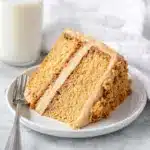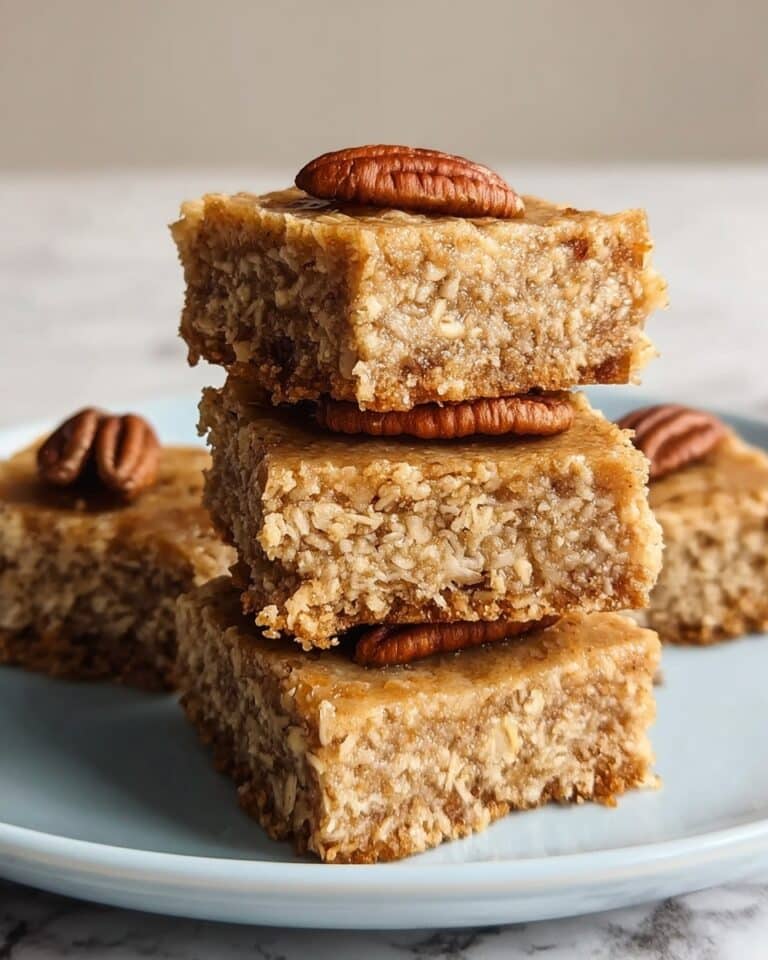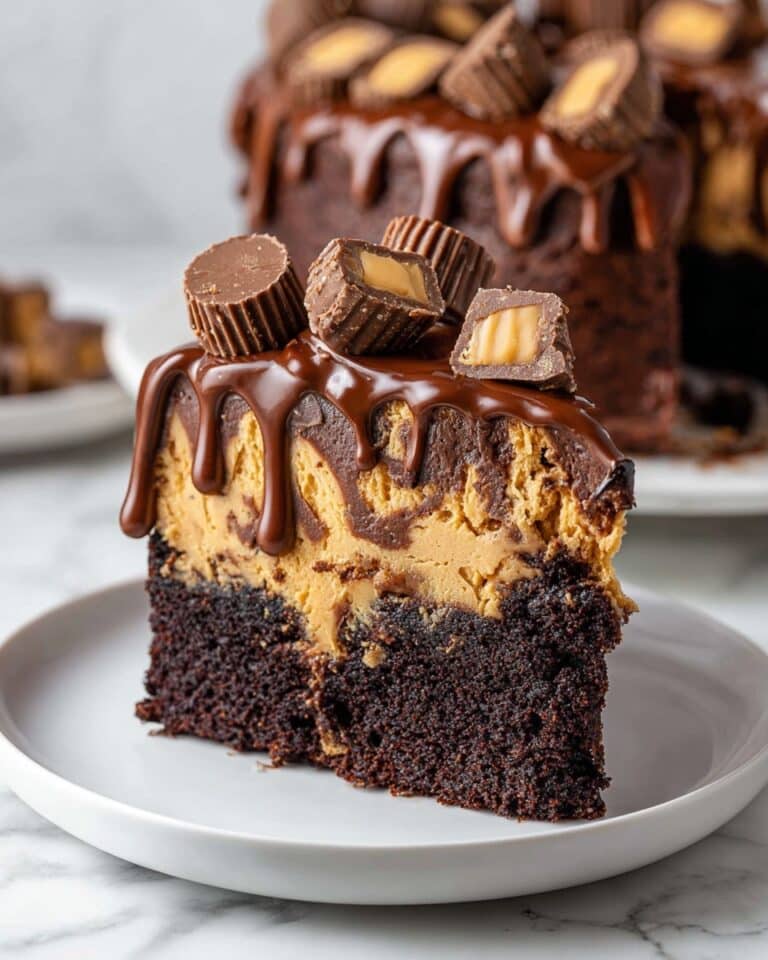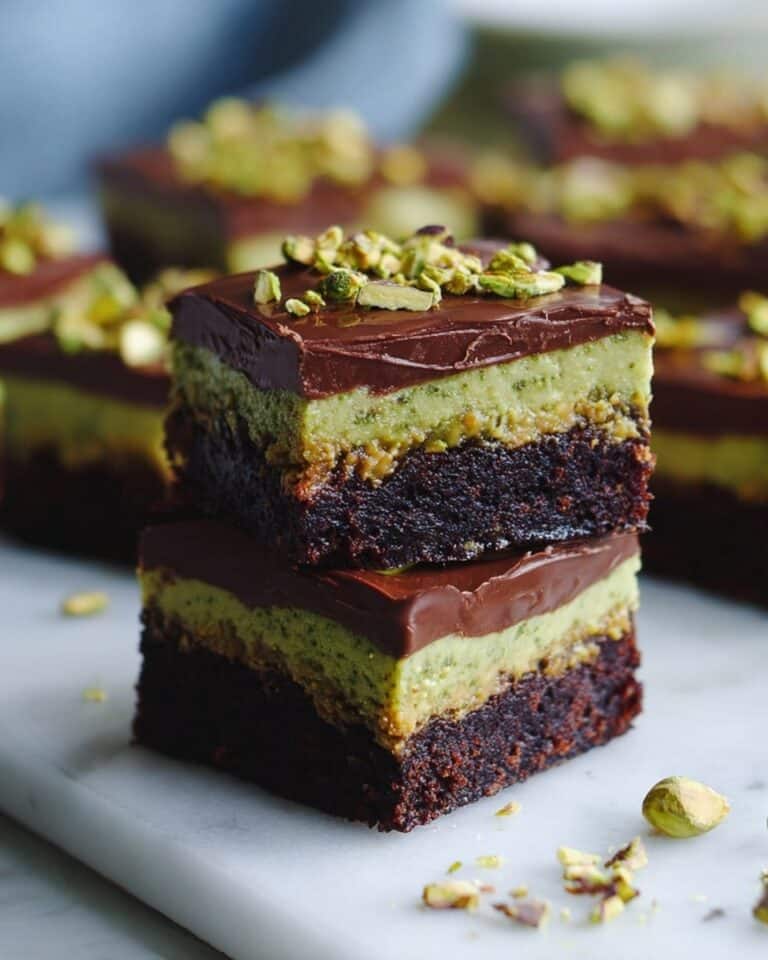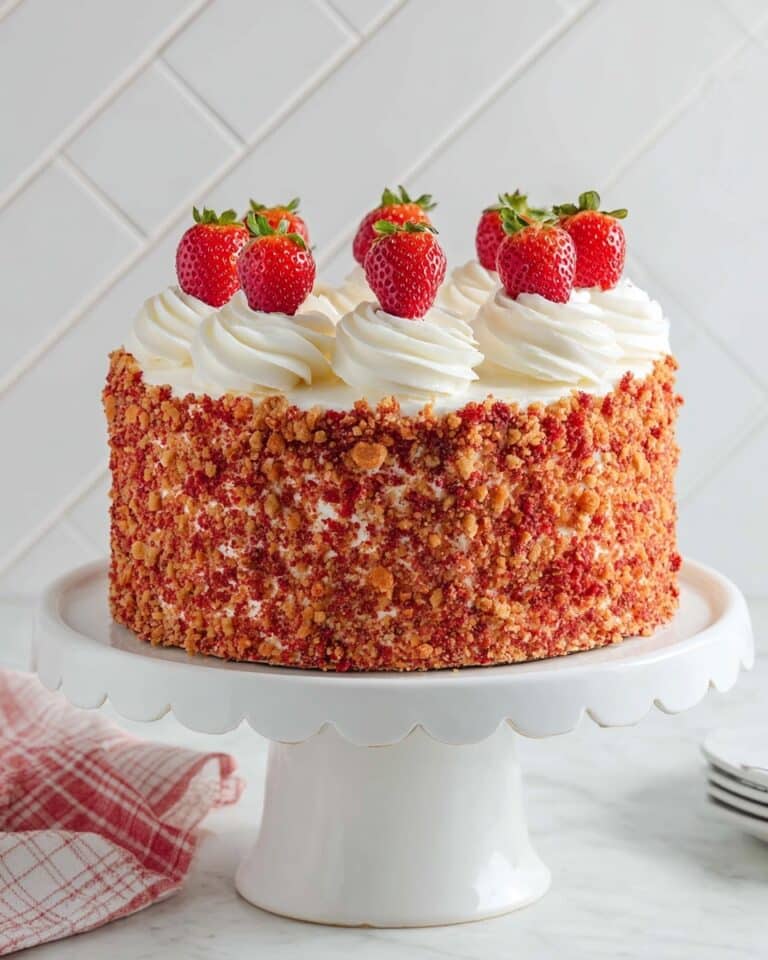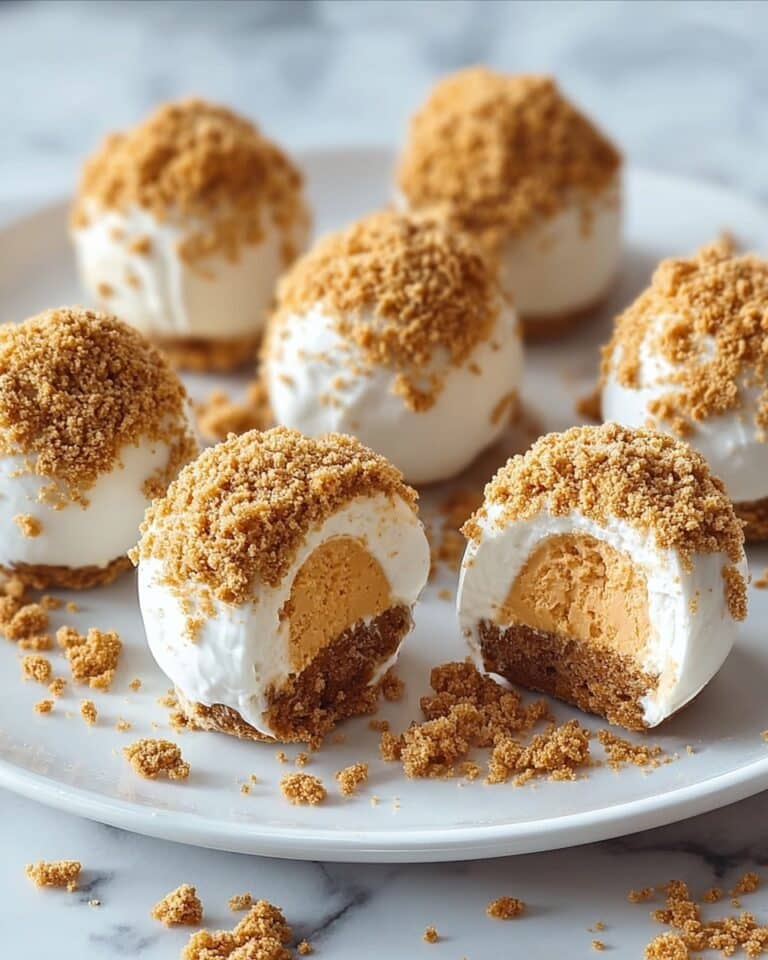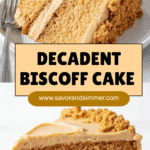Biscoff Cake Recipe
“`html
If you have a sweet tooth that craves both spice and creaminess, you are in for an absolute treat with this Biscoff Cake. This enchanting dessert blends the rich, caramelized flavor of Biscoff spread with a tender, moist crumb and a luscious frosting that will have you coming back for seconds. Perfectly balanced between aromatic cinnamon and the warming notes of brown sugar, this cake captures the cozy essence of your favorite Lotus cookies in every bite. Whether you’re baking for a special occasion or simply to satisfy your comfort-food cravings, the Biscoff Cake is a delightful showstopper that’s as gorgeous as it is delicious.
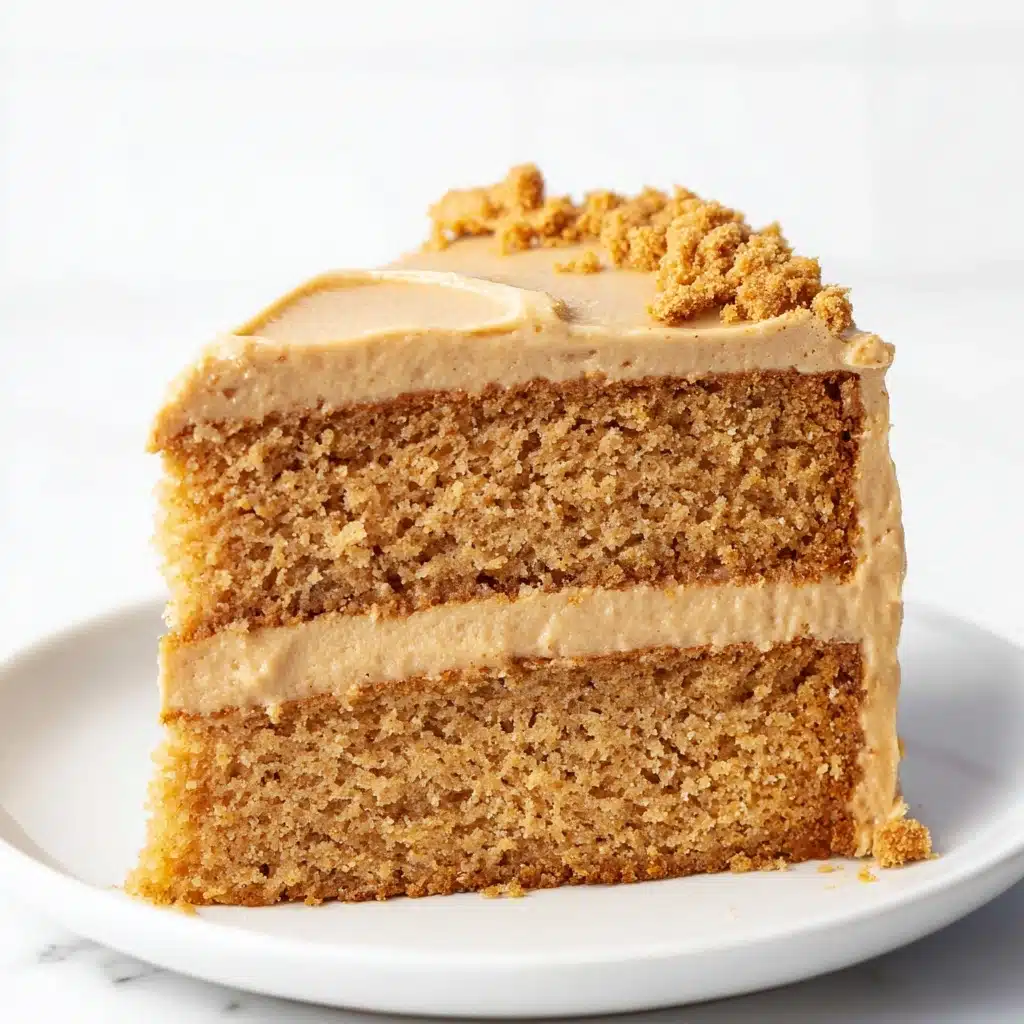
Ingredients You’ll Need
Every ingredient in this recipe is simple but thoughtfully chosen to build the cake’s sumptuous texture and deep flavor layers. Fresh eggs provide richness, buttermilk adds moisture and a subtle tang, and the mix of sugars creates just the right sweetness and caramel notes for that iconic Biscoff flavor.
- All-purpose flour (2 1/2 cups / 312 grams): The foundation for a soft, fluffy cake crumb.
- Baking powder (1 1/2 teaspoons): Helps the cake rise beautifully to a light texture.
- Baking soda (1/2 teaspoon): Works alongside baking powder for the perfect lift.
- Salt (1/2 teaspoon): Balances sweetness and enhances other flavors.
- Unsalted butter (1/2 cup + 1 cup, 112 g + 226 g, softened): Adds creaminess and richness, crucial for both the cake and frosting.
- Brown sugar (1/2 cup / 105 grams): Provides deep molasses notes for warmth and moisture.
- Granulated sugar (3/4 cup / 150 grams): Adds sweetness and helps with the cake’s tender crumb.
- Biscoff spread (2/3 cup): The star ingredient, lending that signature spiced caramel flavor.
- Vegetable oil (1/2 cup / 120 ml): Keeps the cake moist and tender.
- Vanilla extract (2 teaspoons + 1 teaspoon): Enhances all the sweet flavors with its warm aroma.
- Large eggs (3, room temperature): Bind the ingredients together and add structure.
- Buttermilk (1 1/4 cup / 300 ml, room temperature): Lends a subtle tang and tender crumb.
- Cream cheese (2 ounces / 56 grams, full-fat): Adds silkiness and a slight tang to the frosting.
- Cinnamon (1/2 teaspoon): Elevates the frosting’s spice profile for extra depth.
- Powdered sugar (2 1/2 to 3 cups / 275-330 grams): Sweetens and thickens the frosting perfectly.
- Whipping cream or milk (1-2 tablespoons): Adjusts frosting texture for spreading or piping.
- Biscoff spread (1/3 cup, warmed): Used in the assembly for a gooey, decadent layer inside the cake.
- Lotus cookies, crushed (4-6 cookies): Adds a delightful crunch and extra Biscoff flavor on top.
How to Make Biscoff Cake
Step 1: Prepare Your Pans and Dry Ingredients
First things first: preheat your oven to 350°F (180°C). Line the bottoms of two 8-inch round cake pans with parchment paper, and lightly grease the sides to prevent sticking. In a medium bowl, whisk together the all-purpose flour, baking powder, baking soda, and salt. Mixing these dry ingredients separately ensures they are evenly distributed, giving the cake a uniform rise and texture.
Step 2: Create the Butter and Sugar Base
In a large bowl, beat the softened butter, brown sugar, granulated sugar, and the star Biscoff spread together until the mixture is smooth and lump-free. This step is crucial because the creamed butter and sugars act as a fluffy base that traps air, making your cake wonderfully light.
Step 3: Incorporate Oil, Vanilla, and Eggs
Add the vegetable oil and vanilla extract to the creamed mix and beat them in thoroughly. Then, introduce the eggs one at a time, making sure each is fully incorporated before adding the next. This method creates a silky batter with great volume, which will help your Biscoff Cake rise evenly and stay moist.
Step 4: Alternately Mix Dry Ingredients and Buttermilk
Now comes the rhythmic part — alternating the dry ingredients and the buttermilk into the wet mixture. Start by whisking in one-third of the flour mixture, followed by half of the buttermilk. Repeat with the next third of flour, the rest of the buttermilk, and finally the last third of the flour. Stop as soon as the batter is smooth and lump-free to avoid overmixing, which can toughen the crumb.
Step 5: Bake Your Cake Layers
Divide the batter evenly between the two prepared pans. Pop them into the middle rack of your preheated oven and bake for 35 to 40 minutes. You’ll know they’re ready when the edges pull away slightly, and a toothpick inserted into the center comes out clean. Let the cakes cool in their pans for at least 15 minutes before carefully transferring them to a rack or plate — these layers are delicate, so handle with care!
Step 6: Whip Up the Biscoff Frosting
For the frosting, beat the softened butter in a bowl until fluffy. Add the cream cheese and Biscoff spread and mix until completely smooth and homogenous. Gradually add powdered sugar in stages with vanilla, cinnamon, and salt (if using unsalted butter) beating on low speed initially, then medium. Incorporate the rest of the powdered sugar and a bit of cream or milk as needed until the frosting is creamy, spreadable, and just sweet enough to complement the cake.
Step 7: Assemble Your Biscoff Cake
Warm the extra Biscoff spread in a small bowl in the microwave for 30-45 seconds on medium, stirring until smooth — it should be lovely and pourable but never hot. Level the cake layers with a gentle sawing motion if their tops are domed. Place the first layer on your serving plate, frost a thin crumb coat, then pipe a decorative ring of frosting around the edge or spread a thick band. Spoon and spread the warmed Biscoff inside the piped edge, then sprinkle crushed Lotus cookies over top for a crunchy surprise. Place the second layer on top, frost the sides lightly, and chill for 20 minutes to set. Finish by frosting the sides and top with gorgeous swirls of frosting and an extra sprinkle of crushed cookies.
How to Serve Biscoff Cake
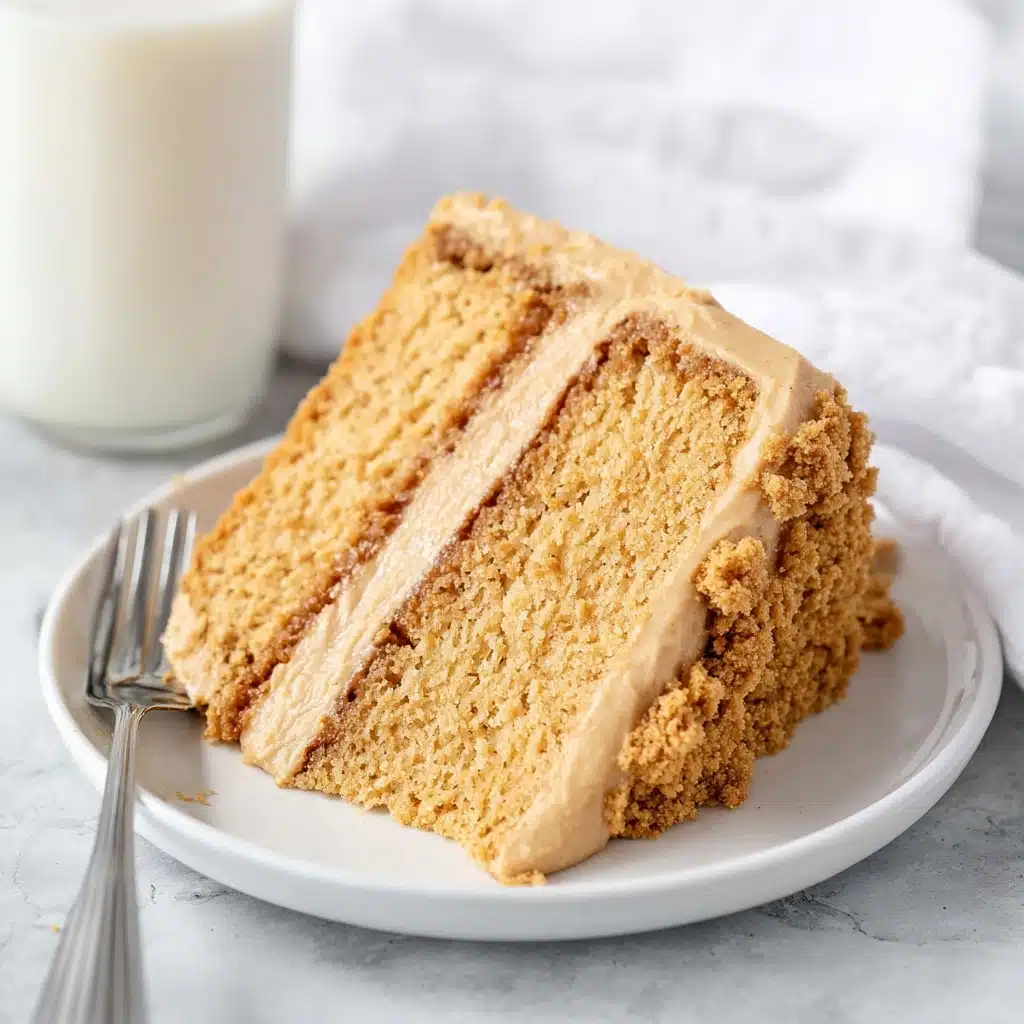
Garnishes
Enhance your Biscoff Cake’s irresistible look and flavor with a handful of crushed Lotus cookies sprinkled over the top. A delicate dusting of cinnamon or a few whole Lotus cookies artistically placed can add a rustic charm and invite your guests to dig in with even more enthusiasm.
Side Dishes
This cake pairs wonderfully with a freshly brewed cup of coffee or a silky latte — they amplify the caramel-cinnamon notes of the Biscoff. For a refreshing contrast, serve slices alongside fresh berries or a dollop of lightly whipped cream to add brightness to each bite.
Creative Ways to Present
Want to wow your friends? Try presenting the Biscoff Cake as individual mini-layered cakes or even cupcakes using the same batter and frosting. For an elegant twist, drizzle some melted Biscoff spread or caramel over each slice just before serving. Adding edible gold flakes or a sprinkle of toasted nuts can also turn this humble cake into a decadent centerpiece.
Make Ahead and Storage
Storing Leftovers
Leftover Biscoff Cake stores beautifully in an airtight container in the refrigerator for up to four days. The flavors even deepen after resting, making it perfect to prepare a day ahead and enjoy later without any loss of moisture or texture.
Freezing
To freeze, wrap the cake tightly in plastic wrap and then in foil, or place it in an airtight container. Frozen, it will keep well for up to two months. When you’re ready to enjoy, thaw the cake in the refrigerator overnight for best results. This way, you can always have a slice of your favorite Biscoff Cake on hand for unexpected guests or a sudden dessert craving.
Reheating
If you prefer your slice slightly warmed, gently reheat it in the microwave for 10-15 seconds or until just warm, but be careful not to melt the frosting completely. This little trick wakes up all the cozy flavors and enhances the cake’s softness without compromising its beautiful presentation.
FAQs
Can I substitute regular butter with salted butter in the Biscoff Cake recipe?
Yes, you can use salted butter if that’s what you have on hand, but be sure to omit the additional salt called for in the recipe. This will keep the saltiness balanced so your Biscoff Cake tastes perfectly sweet without any unwanted saltiness.
Is it necessary to use buttermilk or can I replace it?
Buttermilk adds a slight tang and helps tenderize the crumb, but if you don’t have any, you can easily make a substitute by adding 1 tablespoon of lemon juice or white vinegar to 1 1/4 cups of milk and letting it sit for 5 minutes before using.
Can I make this Biscoff Cake dairy-free?
Absolutely! Swap the butter and cream cheese in the frosting for dairy-free alternatives like plant-based margarine and vegan cream cheese. Use a non-dairy milk for the buttermilk substitute, and the cake will still turn out moist and delicious with that iconic Biscoff flavor.
How long does the Biscoff Cake last at room temperature?
Because the frosting contains cream cheese and butter, it’s best to store the cake in the refrigerator and consume within 3-4 days. At room temperature, it should only be left out for up to 2 hours to ensure freshness and food safety.
Can the cake layers be baked ahead of time without frosting?
Yes! You can bake the cake layers a day or two in advance, wrap them tightly, and store them at room temperature. When ready to assemble, just prepare the frosting and put it all together for a fuss-free process on the day you want to serve.
Final Thoughts
This Biscoff Cake isn’t just a dessert — it’s an experience that awakens the senses and brings a touch of magic to any occasion. The melding of spiced caramel flavors with tender crumb and luscious frosting makes it an absolute favorite to bake and share with loved ones. I wholeheartedly encourage you to try this recipe and discover why the Biscoff Cake has won over the hearts of so many sweet lovers. Happy baking!
“`
PrintBiscoff Cake Recipe
This luscious Biscoff Cake combines moist layers of spiced cake infused with creamy Biscoff spread and a rich Biscoff cream cheese frosting. Finished with crushed Lotus cookies and warm Biscoff drizzle, this cake is perfect for spice lovers and dessert enthusiasts seeking a unique, flavorful treat with a delightful crunch.
- Prep Time: 30 minutes
- Cook Time: 40 minutes
- Total Time: 1 hour 10 minutes
- Yield: 12 servings 1x
- Category: Dessert
- Method: Baking
- Cuisine: American
- Diet: Vegetarian
Ingredients
Dry Ingredients
- 2 1/2 cups all-purpose flour (312 grams)
- 1 1/2 teaspoons baking powder
- 1/2 teaspoon baking soda
- 1/2 teaspoon salt
Wet Ingredients for Cake
- 1/2 cup unsalted butter, softened (112 grams)
- 1/2 cup brown sugar (105 grams), preferably light
- 3/4 cup granulated sugar (150 grams), caster sugar works too
- 2/3 cup Biscoff spread
- 1/2 cup vegetable oil or canola oil (120 ml)
- 2 teaspoons vanilla extract
- 3 large eggs, room temperature
- 1 1/4 cups buttermilk, room temperature (300 ml)
Frosting Ingredients
- 1 cup unsalted butter, softened (226 grams)
- 2 ounces cream cheese, full-fat (56 grams), or substitute with an extra 1/4 cup butter
- 3/4 cup Biscoff cookie butter
- 1/2 teaspoon cinnamon
- 1/4 teaspoon salt (omit if using salted butter)
- 1 teaspoon vanilla extract
- 2 1/2 to 3 cups powdered sugar (275–330 grams), adjusted for sweetness and thickness
- 1–2 tablespoons whipping cream or milk, to adjust consistency
Decorations
- 1/3 cup Biscoff spread, warmed
- 4–6 crushed Lotus Biscoff cookies
Instructions
- Preheat and Prepare Pans: Preheat your oven to 350°F (180°C). Line the bottoms of two 8-inch (20 cm) round cake pans with parchment paper and lightly grease the sides to ensure easy removal.
- Mix Dry Ingredients: In a medium bowl, whisk together the all-purpose flour, baking powder, baking soda, and salt until well combined to ensure even leavening throughout the cake.
- Cream Butter and Sugars: In a large bowl, beat the softened unsalted butter, brown sugar, granulated sugar, and Biscoff spread until the mixture is smooth with no lumps of butter or sugar remaining, which helps create a light texture.
- Add Oil and Vanilla: Beat the vegetable oil and vanilla extract into the butter mixture until fully incorporated, which adds moisture and depth of flavor to the cake batter.
- Incorporate Eggs: Add the eggs one at a time, beating well after each addition to ensure they are fully mixed and create a stable batter.
- Alternately Add Dry Ingredients and Buttermilk: Using a wire whisk, add about one-third of the dry flour mixture to the wet ingredients, then stir in half of the buttermilk. Repeat by adding another third of the dry ingredients followed by the remaining buttermilk, and finally whisk in the remaining dry ingredients. Mix just until no dry lumps remain to avoid overmixing, which can toughen the cake.
- Divide Batter and Bake: Evenly distribute the batter between the prepared pans and bake in the center rack of the preheated oven for 35 to 40 minutes. The cakes are done when the edges start pulling away from the pan and a toothpick inserted in the center comes out clean.
- Cool Cakes: Let the cakes cool in their pans for at least 15 minutes. Then, very gently loosen the edges and transfer the cakes to a wire rack to cool completely. Handle carefully as the cakes are delicate.
- Prepare Frosting: In a large bowl, beat the softened butter until creamy. Add cream cheese and Biscoff cookie butter, beating until smooth and homogeneous.
- Add Spices and Sugar: Mix in 2 cups powdered sugar, vanilla extract, cinnamon, and salt with the mixer starting on low speed, then gradually increase to medium until combined. Continue adding the remaining powdered sugar gradually, alternating with small amounts of whipping cream, until the frosting is thick, smooth, and reaches your preferred sweetness and spreadability.
- Warm Biscoff Spread: Place 1/3 cup Biscoff spread in a small bowl and microwave for 30-45 seconds on medium power until warm and easily spreadable. Stir well and set aside to cool slightly.
- Prepare Cake Layers: If the cake layers have domed tops, use a serrated knife to level the layers carefully for a flat surface, which helps with even stacking and frosting.
- Assemble Layer One: Place one cake layer on your serving plate. Spread a thin layer of frosting on top, then pipe or spread a thicker band of frosting around the edges.
- Add Biscoff and Cookie Crumbs: Spread the warmed Biscoff evenly over the top of the first layer, then sprinkle with crushed Lotus cookies for texture and flavor contrast.
- Stack Second Layer: Place the second cake layer on top and apply a thin crumb coat of frosting around the sides. Refrigerate the cake for about 20 minutes to set the crumb coat.
- Final Frosting and Decoration: Remove the cake from the fridge and apply the final thick layer of frosting on the sides and top, piping decorative swirls if desired. Optionally, garnish the top with additional crushed Lotus cookies to enhance presentation and flavor.
Notes
- Make sure all wet ingredients like eggs and buttermilk are at room temperature to ensure a smooth batter and even baking.
- You can substitute cream cheese in the frosting with an extra 1/4 cup of butter if preferred for a richer buttercream flavor.
- If you do not have buttermilk, add 1 tablespoon lemon juice or vinegar to 1 1/4 cups milk and let sit for 5 minutes to create a buttermilk substitute.
- Use a serrated knife to level the cakes to create flat layers – this will make assembling and frosting easier and more professional-looking.
- Store leftovers covered in the refrigerator for up to 4 days; allow the cake to come to room temperature before serving for the best flavor and texture.
Nutrition
- Serving Size: 1 slice (1/12th of cake)
- Calories: 450 kcal
- Sugar: 35 g
- Sodium: 210 mg
- Fat: 24 g
- Saturated Fat: 12 g
- Unsaturated Fat: 10 g
- Trans Fat: 0.5 g
- Carbohydrates: 52 g
- Fiber: 1 g
- Protein: 5 g
- Cholesterol: 90 mg
Keywords: Biscoff cake, Lotus cookie cake, spiced cake, Biscoff frosting, cream cheese frosting, dessert, layered cake

